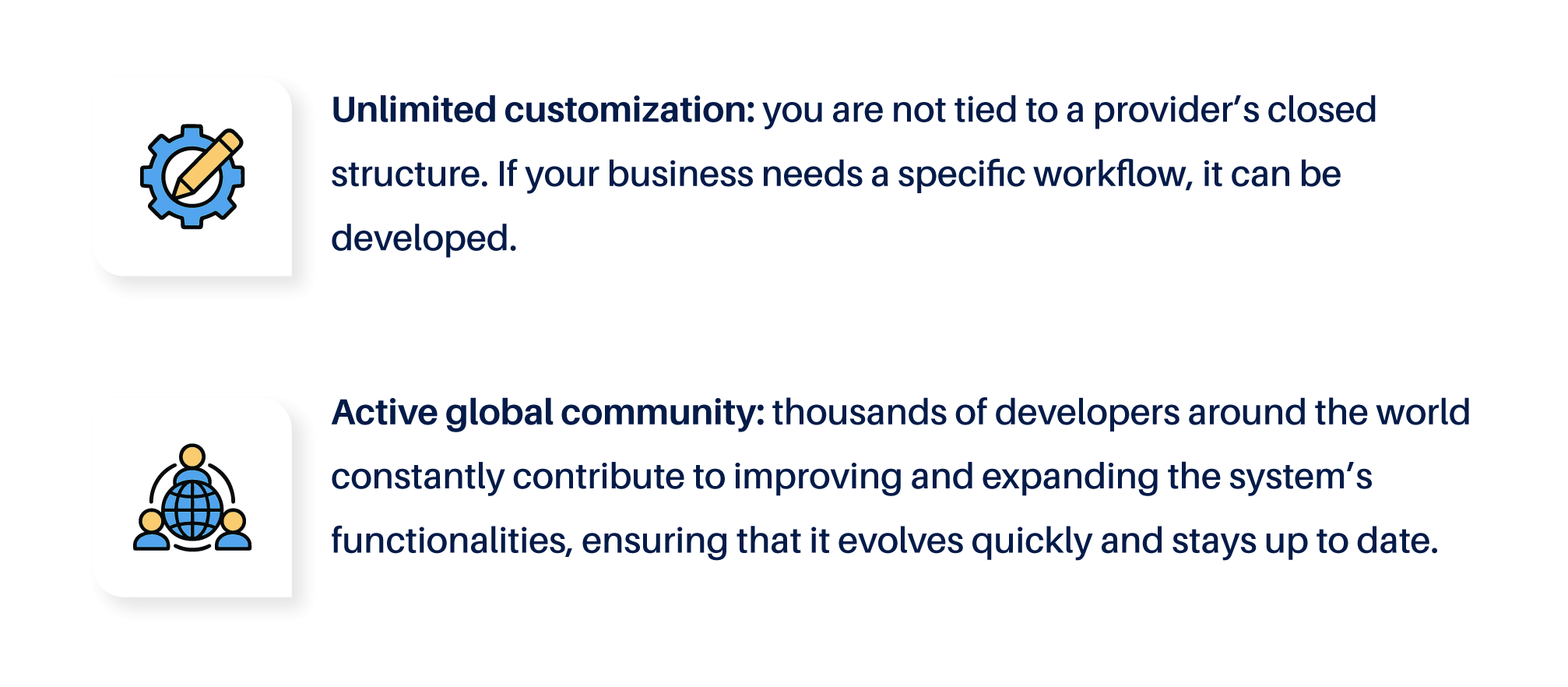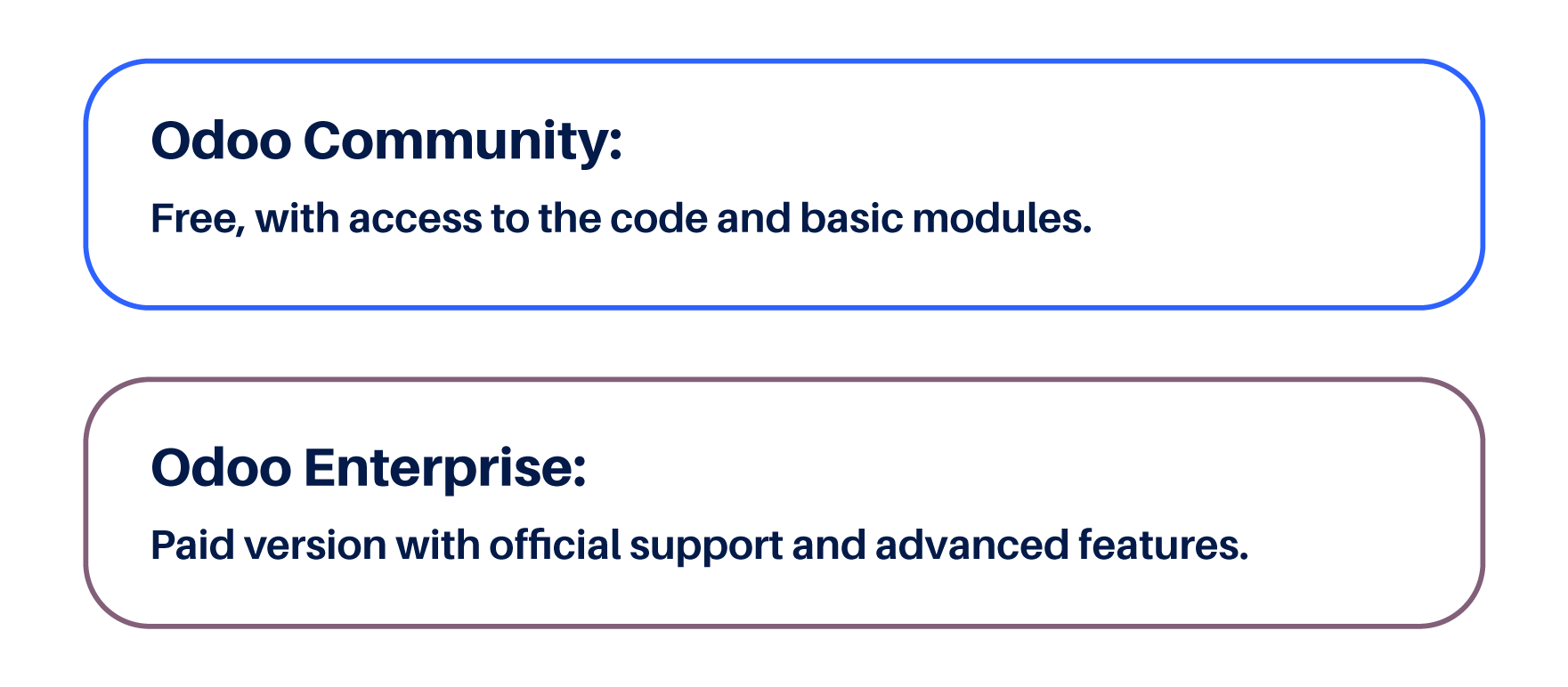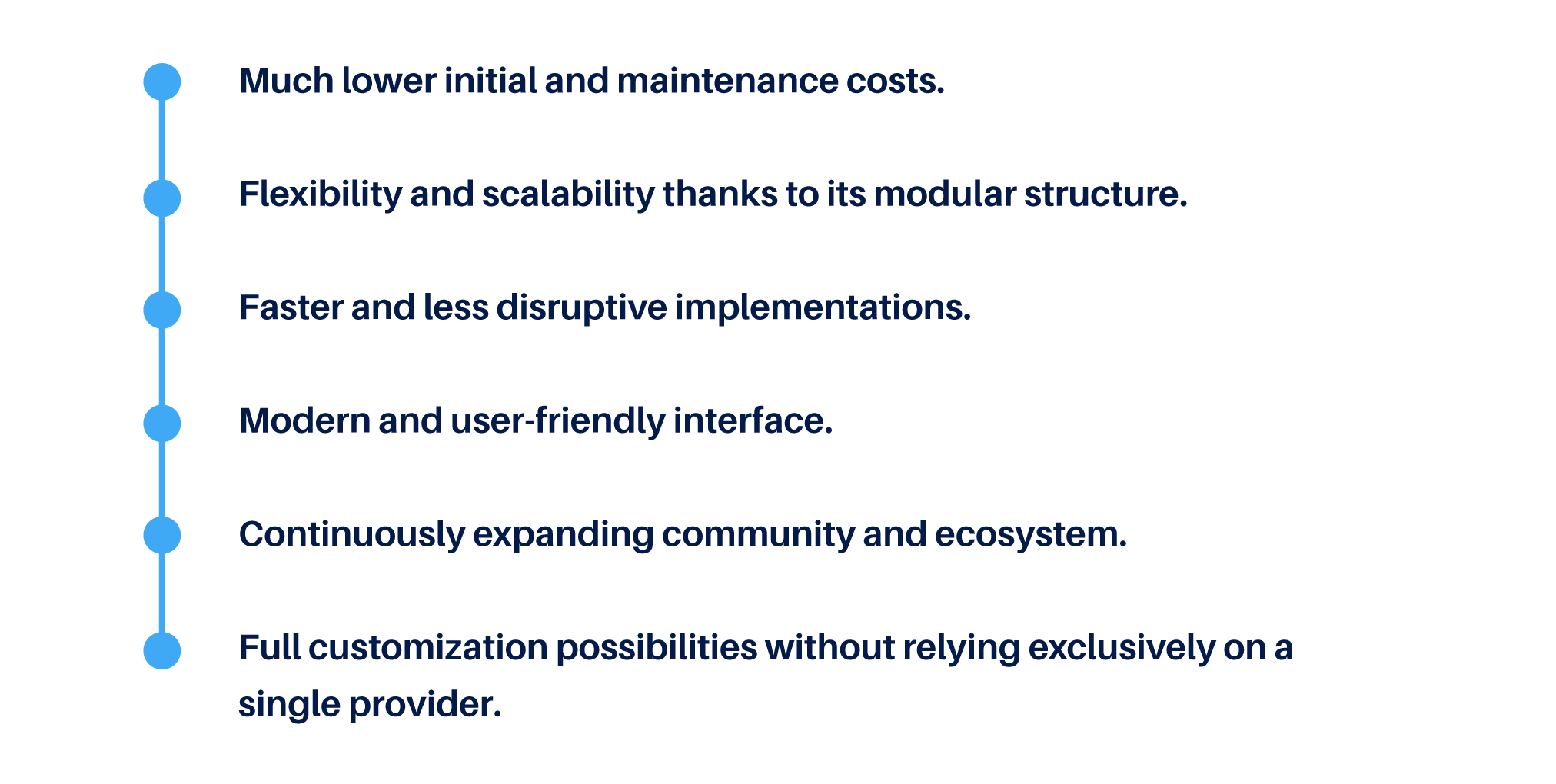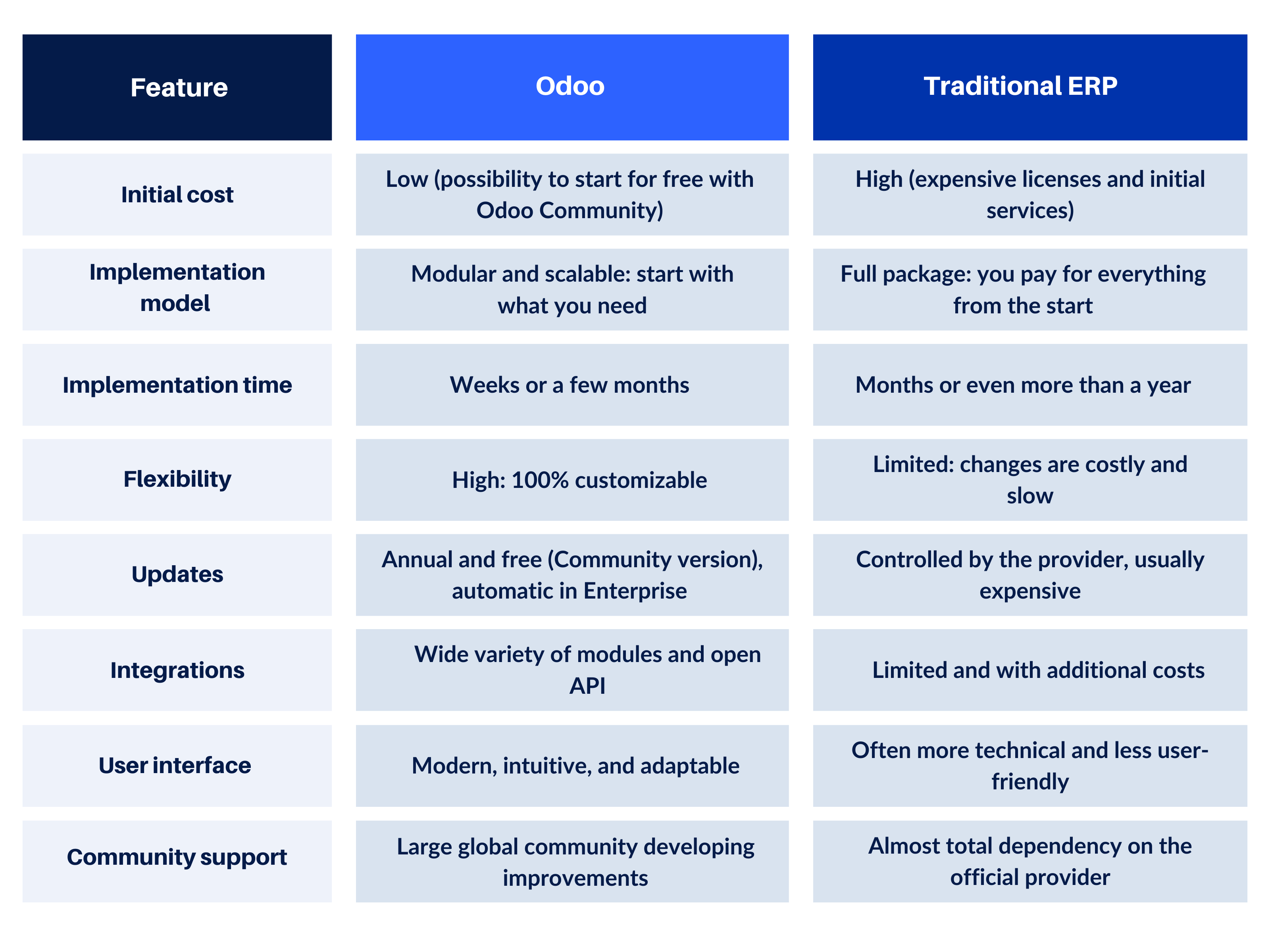What is Odoo and why is it gaining ground compared to traditional ERPs
Odoo is revolutionizing the world of ERPs thanks to its flexibility, affordable costs and fast implementation. In this article, you'll discover why more and more companies prefer it over traditional systems such as SAP, Oracle or Microsoft Dynamics, and how its modular model and global community make it a powerful alternative.

For years, companies that needed to optimize their internal processes had few options: investing in an expensive traditional ERP, waiting months (or even years) for its implementation, and then adapting to a rigid system that, in many cases, did not evolve at the same pace as the business. However, in the last decade, a new protagonist has entered the scene and is revolutionizing the market: Odoo.
This Belgian ERP has grown exponentially and now competes directly with giants such as SAP, Oracle or Microsoft Dynamics. The question is: What is it about Odoo that makes it so attractive compared to traditional ERP systems? Let's explore it thoroughly.
Odoo: a modular and flexible ERP
To understand why Odoo is gaining ground, you first need to know what it is. Odoo is a ERP (Enterprise Resource Planning) open source that integrates all areas of a company on a single platform. From accounting, sales and purchases, to inventory management, human resources, e-commerce or digital marketing.
Unlike traditional ERPs, which are usually sold as a complete package, Odoo works for Modules. This means that a company can start implementing only the areas it needs and then add others as its needs grow or change.
For example, an SME could start with billing and CRM modules, and later add inventory management, point of sale or e-commerce. Not only does this reduce initial costs, but it also allows for a more agile and less traumatic implementation.
Open Source: The Power of Community
One of the main differences compared to large traditional ERPs is that Odoo is Open Source (at least in its Community version). This gives you two key benefits:

In contrast, a traditional ERP often depends exclusively on its official supplier for improvements, which limits the speed of adaptation and makes any changes more expensive.
Costs: The factor that changed the game
Implementing a traditional ERP can involve six- or seven-figure investments, plus recurring licensing, maintenance, and upgrade costs.
Odoo, on the other hand, offers two models:

Even in its Enterprise version, Odoo is usually much more accessible than a traditional ERP, especially since it allows you to start small and grow in a phased manner. This has democratized access to ERP technology, allowing medium and even small companies to have a robust solution without ruining their budget.
Faster deployment
One of the big headaches with traditional ERPs is implementation time. In many cases, it can take more than 12 months from when the contract is signed until the system is fully operational. This means that the return on investment is slow to arrive and that the company may lose agility during the process.
With Odoo, thanks to its modularity and flexibility, the implementation can be carried out in weeks or a few months, depending on the scope. In addition, it is possible to release modules progressively, avoiding abrupt interruptions in operation.
User experience: a modern and friendly interface
Traditional ERPs often carry outdated and unintuitive interfaces. This translates into hours of training and resistance to change on the part of users.
Odoo has invested a lot in user experience design. Its interface is clean, modern and designed so that anyone can learn how to use it quickly. This facilitates internal adoption and reduces training costs.
Integrations and digital ecosystem
We live in an era in which companies use multiple digital tools: from marketing and sales platforms to payment gateways, marketplaces and logistics systems.
Odoo shines in this regard because it has thousands of modules and integrations that allow you to connect the ERP with practically any software or service. In addition, its open API makes it easy to create custom integrations.
A clear example is e-commerce: Odoo not only offers its own fully integrated e-commerce module with inventory and billing, but it can also connect with Shopify, Amazon, Mercado Libre or WooCommerce, avoiding duplication of efforts and synchronization errors.
Why is it gaining ground compared to traditional ERPs
At this point, we can summarize the reasons why Odoo is taking the market away from the giants:

This set of factors makes companies of all sizes, from startups to corporations, interested in Odoo as a viable alternative.
Comparison: Odoo vs Traditional ERP

Real use cases
To better understand the impact of Odoo, let's look at some real examples:
- Growing retail company: a chain of stores that started using Odoo only for its point of sale and billing. Seeing the ease of integration, they added up inventories, purchases and CRM. In less than a year, they had a complete ERP for a fraction of the cost of a traditional system.
- Industrial manufacturer: used to a legacy system that didn't integrate with their new processes, they migrated to Odoo to unify production, inventory, quality and logistics. This allowed them to reduce errors by 40% and improve delivery times.
- International e-commerce: used Odoo to centralize sales from Amazon, Shopify and their own store, synchronizing inventories and billing in real time, reducing returns and improving the customer experience.
The learning curve and its challenges
Not everything is perfect. Although Odoo is flexible and powerful, it requires a good implementation plan and an experienced technology partner to avoid errors. Some companies fall into the trap of trying to implement it without professional support, which can lead to chaos and delays.
Another point to consider is that, being so customizable, it's easy to fall into overconfiguration. The key is to implement what is really needed and to leave room to grow in an orderly manner.
The Future of Odoo
Over the past few years, Odoo has grown its user base at an impressive rate, with more than 7 million companies using the platform around the world. Every year it releases a new version with significant improvements, integrating trends such as artificial intelligence, process automation and advanced analytics.
If you continue with this strategy, it is likely that it will continue to gain ground, especially among companies that are looking for a powerful but adaptable ERP, without the commitments and costs of traditional systems.
Conclusion
Odoo isn't just “just another ERP”. It represents a paradigm shift in how companies can adopt business management technology. Your combination of low cost, flexibility, speed of deployment, customization and global community makes it an increasingly attractive option.
While traditional ERPs continue to defend their territory with robust but expensive and rigid solutions, Odoo is moving forward with a fresh proposal that is adaptable to the reality of a constantly changing business world.
For companies looking for transform your management without mortgaging your budget or compromising your agility, Odoo is becoming the ideal answer. And if the current trend continues, it wouldn't be surprising if in a few years we'll see it as the new standard in the industry.

